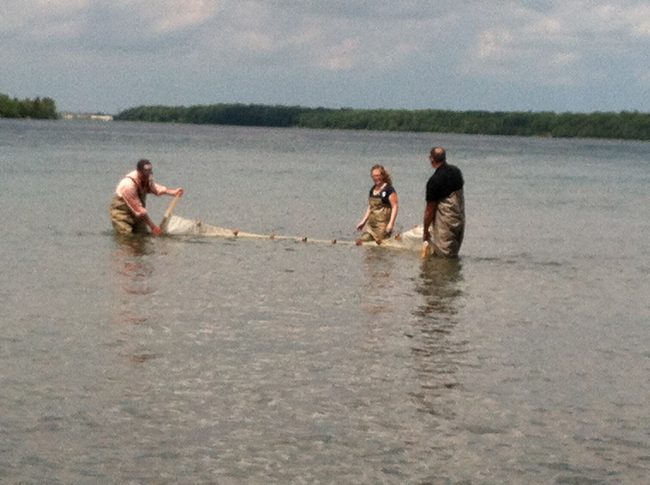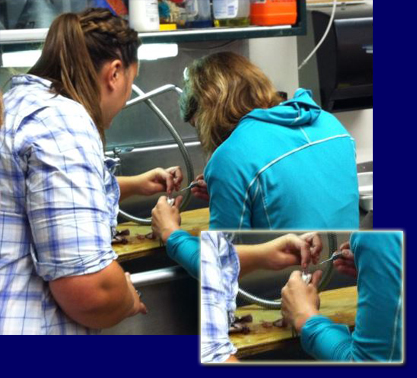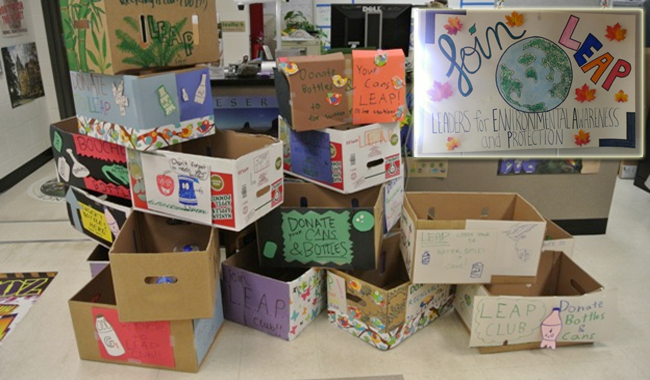— By Helen Domske, NYSG's Coastal Education Specialist
Note: Any teachers in grades 4-12 interested in upcoming workshop
along the shores of Lake Erie and Lake Ontario, should contact NYSG’s
Education Coordinator, Helen Domske by email hmd4@cornell.edu for more
information.
Buffalo, NY, December 12, 2014 - Today, teachers are faced with a number of challenges in their classrooms and pressure from administration and the State Education Department often adds to the stress of their jobs. Some teachers let the frustration impact their jobs, while others excel despite the pressures. It is those talented and dedicated teachers that New York Sea Grant (NYSG) partners with to make a “splash” for Great Lakes education.
By using the “Teach-the-Teacher” approach, we engage teachers in experiential learning and provide them with information and classroom-tested curriculum developed by Sea Grant and its parent federal organization, the National Oceanic and Atmospheric Administration (NOAA). Our efforts have helped to build a network of engaged educators who have shared their new-found knowledge and enthusiasm with thousands of students in New York’s coastal communities.
This year, 109 teachers took part in five workshops that focused on Great Lakes watersheds, the Buffalo River, Lake Ontario and Lake Erie. Those teachers agreed to conduct stewardship activities with over 11,325 students from 4th grade through high school.

Water samples are drawn using a Rosette sampler (as seen above) at different locations and depths in the Great Lakes and its tributaries to analyze chemistry and water quality—factors such as surface temperature, dissolved oxygen, pH, and fluorescence (a measure of algae abundance). Biological studies of the water column involve counts of microscopic phytoplankton—photosynthetic organisms like green algae, cyanobacteria, diatoms and dinoflagellates—and zooplankton, a primary food source for Great Lake sportfish such as walleye and yellow perch. Photo: Helen Domske, NYSG.
The workshops took teachers out in the field and focused on interactions with scientists and environmental specialists from the U.S. Environmental Protection Agency, NYS Department of Environmental Conservation, U.S. Geological Survey (see photo above), Buffalo-Niagara Riverkeeper, Cornell University, Buffalo State College and many other partners. The teachers plunged into learning by monitor fish populations with seine nets (see first two photo below), ageing fish using otoliths (ear bones) (see third photo below), collecting and identifying plankton and taking water samples. Many of the teachers have passed these new skills on to their students during meaningful watershed environmental education experiences that are funded through the GLRI project.

Seine nets (like the one seen above) are usually long flat, weighted nets that hang vertically in the water and are used to encircle, and safely collect, fish for study. The fish are then placed into buckets filled with lake or river water and then scooped up for a brief period of study (as seen below) before being placed back into the body of water they came from. Photos: Helen Domske, NYSG

So how can you tell a fish's age using otoliths (as being demonstrated in the photo below)? Otoliths, commonly
known as "earstones," are hard, calcium carbonate structures located
directly behind the brain of bony fishes. Different species have
otoliths of different shapes and sizes; and cartilaginous fishes, such
as sharks, skates, and rays, have none. Biologists estimate fish age by
counting these opaque zones, called annuli, just as one would count
rings on a tree to determine its age. For each species to which it is
applied, the method of estimating age by counting annuli must be
validated to prove that one whole annulus is equal to one year of
growth. Photo: Helen Domske, NYSG.

Funding for several of the workshops came through the Center for Great Lakes Literacy (CGLL) and USEPA’s Great Lakes National Program Office (GLNPO) through the Great Lakes Restoration Initiative (GLRI). CGLL is a project that involves the seven Sea Grant programs in the Great Lakes and NYSG is the lead on Lake Ontario efforts and takes part in Lake Erie programming. Check out coseegreatlakes.net to learn more about CGLL and its mission of developing a community of Great Lakes literate educators, students, scientists, environmental professionals, and citizen volunteers, dedicated to improved Great Lakes stewardship.
The stewardship activities were as diverse as the schools represented, ranging from beach clean-ups and water-quality monitoring, to the creation of educational videos and building new nature trails near one of the schools. Although there too many innovative projects to detail, some outstanding efforts are worth highlighting. Efforts like the ones below empower teachers, making them realize they can help
their students become the next generation of informed Great Lakes
citizens.
- A real “LEAP” forward came from students in Williamsville High School, under the guidance of teacher Kim Preshoff, who started a club called LEAP, which stands for Leaders for Environmental Awareness and Protection. Their goal was to set up a recycling program for plastic water bottles to remove them from the waste stream and protect local water sources. They also wanted to encourage using refillable water bottles so they set a second goal to collect enough money to convert a water fountain to a refillable station that counted the number of plastic water bottles saved through its use. So far, the students have collected enough to purchase one water station and efforts continue this school year to earn enough to purchase a second one.

After completing a of Great Lake workshop with NYSG Coastal Education Specialist Helen Domske, a teacher and students at Williamsville North High School formed a new Environmental Club. To date, members have collected over 4.000 returnable cans/bottles. "We've found that there are an incredible amount of plastic bottles and containers out there without deposits on them that are now being removed from the garbage and placed into a recycling container thanks to this effort," said teacher and club faculty adviser Kim Preshoff. "Faculty and staff are even making more of a conscious effort to get their 'cans' up and recycle in a nearby bin." Photos: Kim Preshoff.
- After taking part in the Buffalo River workshop, Amanda Jasper, a high school teacher from Global Concepts Charter School in Lackawanna, focused the instruction in her AP Biology curriculum on the history and environmental concerns of the Buffalo River. As a part of the class, students worked on creating a public service announcement video and put it on YouTube to bring awareness of issues and restoration happening at the site. As Amanda indicates, “I am very proud of my students, as they took this project very seriously and have learned so much about the area they live in. They have told me they really enjoyed learning about something they are so close to.”
Interested in the comeback of the Buffalo River? You're in luck. AP biology students at the Global Concepts Charter School in Lackawanna, NY have created a video PSA explaining cleanup efforts and their importance in one of the nation's most industrialized rivers. She got the idea for the video after attending a workshop hosted by the New York and Illinois-Indiana Sea Grant programs introducing a new curriculum that connects students in living near the Buffalo River to environmental projects in their community.
Remediation projects have been underway in the Buffalo River since 2011. The latest phase of the project is expected to get rid of approximately 500,000 cubic yards of contaminated sediment, bringing the total to around a million. The Great Lakes Legacy Act project also includes planting native species to help restore underwater habitats.
More Info:
New York Sea Grant (NYSG), a cooperative program of Cornell University
and the State University of New York, is one of 33 university-based
programs under the National Sea Grant College Program (NSGCP) of the
National Oceanic and Atmospheric Administration (NOAA). The NSGCP
engages this network of the nation’s top universities in conducting
scientific research, education, training and extension projects designed
to foster science-based decisions about the use and conservation of our
aquatic resources. Through its statewide network of integrated
services, NYSG has been promoting coastal vitality, environmental
sustainability, and citizen awareness about the State’s marine and Great
Lakes resources since 1971.
For updates on Sea Grant activities: www.nyseagrant.org has RSS, Facebook, Twitter, and YouTube links. NYSG also offers a free e-list sign up via www.nyseagrant.org/coastlines for NY Coastlines, its flagship publication, which merged with our e-newsletter, Currents, in 2014 - is published several times a year.